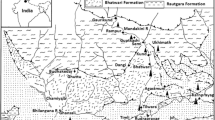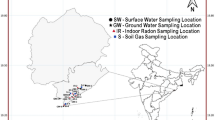Abstract
Radiation exposure, an inescapable share of our everyday life, primarily arises from terrestrial or cosmic sources. A small fragment of the total dose is also contributed by our own bodies. Humans receive an average radiation of 2.4 mSv y−1 as natural background radiation. In the present study, an attempt to quantify groundwater radon-222 and indoor radon, thoron and their progeny was made using both active as well as passive techniques. Solid state nuclear track detectors (LR-115 type-II films) were employed for long-term passive measurements while as scintillation based radon monitor was used for active short-term measurements.






Similar content being viewed by others
References
UNSCEAR (2000) Sources and effects of ionizing radiation: United Nations Scientific Committee on the Effects of Atomic Radiation. UNSCEAR 2000 Rep to Gen Assem
WHO (2009) WHO Handbook on Indoor Radon
Nazaroff WW, Moed BA, Sextro RG (1988) Soil as a Source of Indoor Radon, Generation, Migration, and Entry. In: Radon and its decay products in indoor W.W. Nazaroff, A.V. Nero Jr.
Tanner AB (1978) Natural radiation. In: Radiation and health. Taylor & Francis, Abingdon, UK
Nazaroff WW (1992) Radon transport from soil to air. Rev. Geophys. https://doi.org/10.1029/92RG00055
Prasad G, Prasad Y, Gusain GS, Ramola RC (2008) Measurement of radon and thoron levels in soil, water and indoor atmosphere of Budhakedar in Garhwal Himalaya. Radiat Meas, India. https://doi.org/10.1016/j.radmeas.2008.04.050
Brahmanandhan GM, Selvasekarapandian S, Malathi J et al (2008) Seasonal variation of indoor gamma dose and radon, thoron measurement in the dwellings around kudankulam nuclear power plant (Radhapuram Taluk, Tirunelveli District). Indoor Built Environ 17:384–389. https://doi.org/10.1177/1420326X08094817
Axelsson G, Andersson EM, Barregard L (2015) Lung cancer risk from radon exposure in dwellings in Sweden: how many cases can be prevented if radon levels are lowered? Cancer Causes Control. https://doi.org/10.1007/s10552-015-0531-6
Darby S, Hill D, Auvinen A et al (2005) Radon in homes and risk of lung cancer: collaborative analysis of individual data from 13 European case-control studies. BMJ 330:223. https://doi.org/10.1136/bmj.38308.477650.63
Krewski D, Lubin JH, Zielinski JM et al (2006) A combined analysis of north American case-control studies of residential radon and lung cancer. J Toxicol Environ Heal - Part A. https://doi.org/10.1080/15287390500260945
Matiullah MW (2017) Measurement of radon concentration levels in Pakistan: an overview. Indoor Built Environ 26:1319–1334. https://doi.org/10.1177/1420326X16645849
Ponciano-Rodríguez G, Gaso MI, Armienta MA et al (2020) Indoor radon exposure and excess of lung cancer mortality: the case of Mexico—an ecological study. Environ Geochem Health. https://doi.org/10.1007/s10653-020-00662-8
Samet JM, Avila-Tang E, Boffetta P et al (2009) Lung cancer in never smokers: clinical epidemiology and environmental risk factors. Clin Cancer Res 15:5626–5645. https://doi.org/10.1158/1078-0432.CCR-09-0376
Shang B, Chen B, Gao Y et al (2005) Thoron levels in traditional Chinese residential dwellings. Radiat Environ Biophys 44:193–199. https://doi.org/10.1007/s00411-005-0020-5
Brudecki K, Li WB, Meisenberg O et al (2014) Age-dependent inhalation doses to members of the public from indoor short-lived radon progeny. Radiat Environ Biophys. https://doi.org/10.1007/s00411-014-0543-8
Meisenberg O, Tschiersch J (2011) Thoron in indoor air: modeling for a better exposure estimate. Indoor Air. https://doi.org/10.1111/j.1600-0668.2010.00697.x
Tokonami S (2010) Why is 220Rn (thoron) measurement important? Radiation. Prot. Dosimetry. 141(4): 335–339. https://doi.org/10.1093/rpd/ncq246
Otton, J. K. (1992). The geology of radon. Washington: Government Printing Office.
Saad AF, Al-Awami HH, Hussein NA (2014) Radon exhalation from building materials used in Libya. Radiat Phys Chem. https://doi.org/10.1016/j.radphyschem.2014.03.030
Kumar M, Kaushal A, Sarin A et al (2018) Radon/thoron and progeny levels in dwellings: regional variations and effect of dwelling characteristics—A case study in Jalandhar district of Punjab, India. Indoor Built Environ 27:706–714. https://doi.org/10.1177/1420326X16687614
Thabayneh KM (2015) Measurement of 222 Rn concentration levels in drinking water and the associated health effects in the Southern part of West bank—Palestine. Appl Radiat Isot 103:48–53. https://doi.org/10.1016/j.apradiso.2015.05.007
Omori Y, Tokonami S, Ishikawa T et al (2015) A pilot study for dose evaluation in high-level natural radiation areas of Yangjiang, China. J Radioanal Nucl Chem. https://doi.org/10.1007/s10967-015-4286-z
Al Zabadi H, Mallah K, Saffarini G (2015) Indoor exposure assessment of radon in the elementary schools, Palestine. Int J Radiat Res 13:221–228
Kollerud R, Blaasaas K, Ganerød G et al (2013) Prediction of indoor radon concentrations in dwellings in the Oslo region—a model based on geographical information systems. Nat Hazards Earth Syst Sci Discuss. https://doi.org/10.5194/nhessd-1-3045-2013
Bochicchio F, Campos-Venuti G, Piermattei S, et al (2005) Annual average and seasonal variations of residential radon concentration for all the Italian Regions. In: Radiation Measurements
Wilkening M, Wicke A (1986) Seasonal variation of indoor RN at a location in the southwestern United States. Health Phys. https://doi.org/10.1097/00004032-198610000-00002
Rani S, Kansal S, Singla AK et al (2021) Radiological risk assessment to the public due to the presence of radon in water ofBarnala district. India. Environ Geochem Health, Punjab. https://doi.org/10.1007/s10653-021-01012-y
Kumar M, Sharma N, Sarin A (2018) Prediction of indoor radon/thoron concentration in a model room from exhalation rates ofbuilding materials for different ventilation rates. Acta Geophys. 66:1249–1255. https://doi.org/10.1007/s11600-018-0159-5
Nazir S, Simnani S, Mishra R et al (2020) Simultaneous measurements of radon, thoron and their progeny for inhalation dose assessment in indoors of Srinagar, J&K, India. J Radioanal Nucl Chem 325:315–328. https://doi.org/10.1007/s10967-020-07233-2
Nazir S, Simnani S, Sahoo BK et al (2020) Dose estimation of radioactivity in groundwater of Srinagar City, Northwest Himalaya, employing fluorimetric and scintillation techniques. Environ Geochem Health. https://doi.org/10.1007/s10653-020-00576-5
Nazir S et al (2020) Continuous radon measurements at high altitude physics observatory, Gulmarg, Kashmir valley, J&K, 4. https://doi.org/10.17632/vdzpw2hsbb.4
Qurieshi MA, Masoodi MA, Kadla SA, et al (2011) Gastric cancer in Kashmir
Qurieshi MA, Khan SMS, Masoodi MA et al (2016) Epidemiology of cancers in Kashmir, India: an analysis of hospital data. Adv Prev Med 2016:1–6. https://doi.org/10.1155/2016/1896761
Sahoo BK, Sapra BK, Kanse SD et al (2013) A new pin-hole discriminated 222Rn/220Rn passive measurement device with single entry face. Radiat Meas. https://doi.org/10.1016/j.radmeas.2013.08.003
Prasad G, Prasad Y, Gusain GS, Ramola RC (2008) Measurement of radon and thoron levels in soil, water and indoor atmosphere of Budhakedar in Garhwal Himalaya, India. Radiat Meas 43:S375–S379. https://doi.org/10.1016/j.radmeas.2008.04.050
Kumar S, Siingh D, Singh RP, Singh AK (2016) The influence of meteorological parameters and atmospheric pollutants on lightning, rainfall, and normalized difference vegetation index in the Indo-Gangetic Plain. Int J Remote Sens. https://doi.org/10.1080/01431161.2015.1117680
Kumar A, Vij R, Sharma S, Sarin A (2020) Seasonal variation of indoor radon/thoron and their progeny levels in lesser-Himalayas of Jammu & Kashmir, India. J Radioanal Nucl Chem 323:495–506. https://doi.org/10.1007/s10967-019-06935-6
Singla AK, Kansal S, Mehra R (2021) Dose distribution to individual tissues and organs due to exposure of alpha energies fromradon and thoron to local population of Hanumangarh. Rajasthan. India. J Radioanal Nucl Chem 327:1073–1085
Ramola RC, Prasad M, Kandari T et al (2016) Dose estimation derived from the exposure to radon, thoron and their progeny in the indoor environment. Sci Rep 6:31061. https://doi.org/10.1038/srep31061
Gaware JJ, Sahoo BK, Sapra BK et al (2011) Indigenous development and networking of online radon monitors in the underground uranium mine. Radiat Prot Environ 34:37
Nazir S, Simnani S, Sahoo BK et al (2020) Monitoring geothermal springs and groundwater of Pir Panjal, Jammu and Kashmir, for radon contamination. J Radioanal Nucl Chem 326:1915–1923. https://doi.org/10.1007/s10967-020-07451-8
Kumar M, Kaushal A, Sahoo BK et al (2019) Measurement of uranium and radon concentration in drinking water samples and assessment of ingestion dose to local population in Jalandhar district of Punjab, India. Indoor Built Environ 28:611–618. https://doi.org/10.1177/1420326X17703773
Mishra R, Mayya YS, Kushwaha HS (2009) Measurement of 220Rn/222Rn progeny deposition velocities on surfaces and their comparison with theoretical models. J Aerosol Sci. https://doi.org/10.1016/j.jaerosci.2008.08.001
Mishra R, Mayya YS (2008) Study of a deposition-based direct thoron progeny sensor (DTPS) technique for estimating equilibrium equivalent thoron concentration (EETC) in indoor environment. Radiat Meas 43:1408–1416. https://doi.org/10.1016/j.radmeas.2008.03.002
Mishra R, Prajith R, Sapra BK, Mayya YS (2010) Response of direct thoron progeny sensors (DTPS) to various aerosol concentrations and ventilation rates. Nucl Instruments Methods Phys Res Sect B Beam Interact with Mater Atoms 268:671–675. https://doi.org/10.1016/j.nimb.2009.12.012
Cohen J (1988) Statistical power analysis for the behavioral sciences, 2nd edn. Lawrence Erlbaum Associates
Dar RA, Rashid I, Romshoo SA, Marazi A (2014) Sustainability of winter tourism in a changing climate over Kashmir Himalaya. Environ Monit Assess. https://doi.org/10.1007/s10661-013-3559-7
Acknowledgements
We appreciate the residents of Budgam for their kind cooperation and trust. The authors express gratitude to the editor and the reviewers for their comments on the earlier version of the manuscript that greatly improved the structure and content of this manuscript. A sincere thank you to Rumisa Amin for her diligent proofreading of this manuscript.
Funding
This work was partially supported by the Department of Atomic Energy (DAE), Board of Research in Nuclear Sciences (BRNS), Trombay, Mumbai, India [grant number: 36(4)/14/48/2015-BRNS].
Author information
Authors and Affiliations
Corresponding author
Ethics declarations
Conflict of interest
The author declare that there is no conflict of interest.
Additional information
Publisher's Note
Springer Nature remains neutral with regard to jurisdictional claims in published maps and institutional affiliations.
Rights and permissions
About this article
Cite this article
Nazir, S., Sahoo, B.K., Rani, S. et al. Radon mapping in groundwater and indoor environs of Budgam, Jammu and Kashmir. J Radioanal Nucl Chem 329, 923–934 (2021). https://doi.org/10.1007/s10967-021-07856-z
Received:
Accepted:
Published:
Issue Date:
DOI: https://doi.org/10.1007/s10967-021-07856-z




